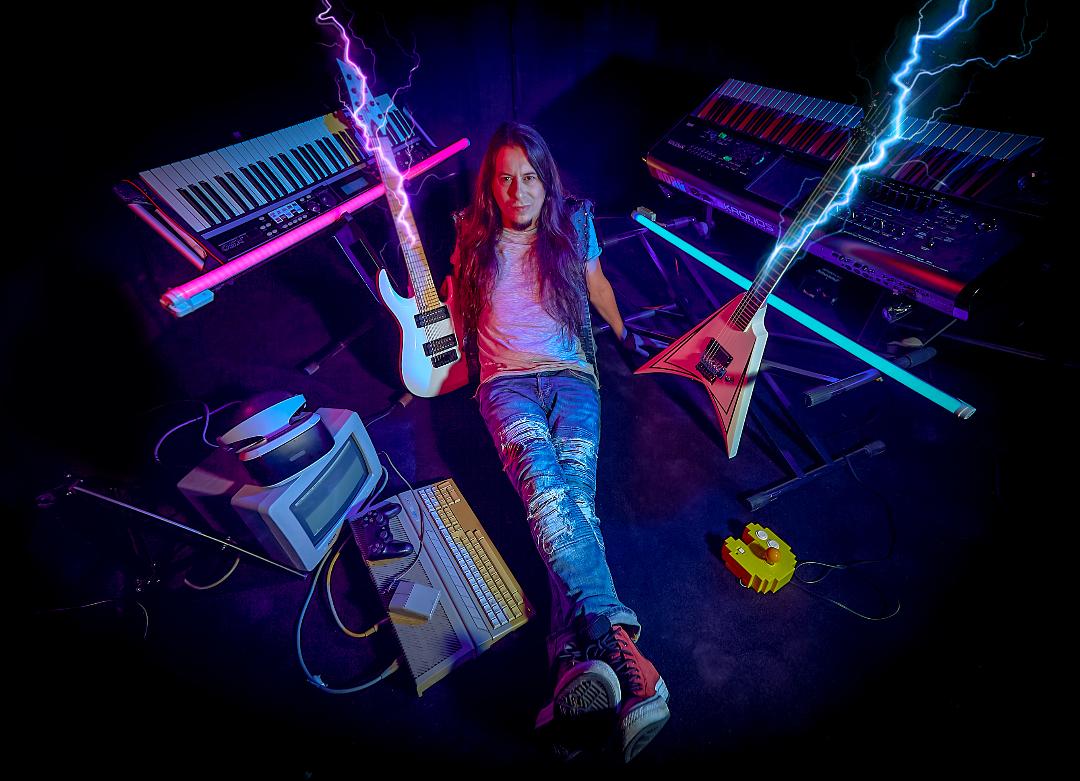BOB KATSIONIS – Video Game Goes Metal!

1. What are your favorite video games from the 80s and the 90s era?
Bob: I grew up being that guy in the school who owned an Amiga 500. Back then, it was the most powerful gaming machine, even it wasn’t considered one. So, some of my favorite late 80’s early 90’s games were Shadow Of The Beast, Another World, Turrican 1+2, Secret Of The Monkey Island, Agony and of course…Kick Off. Later on, I moved to my first PC and there I was only impressed by the Sierra line of adventure games, like Leisure Suit Larry and the whole franchise of Police Quest, King’s Quest, Space Quest and Goldrush.
2. Why do you think that the sound of those old games was so unique?
Bob: Well…it was actually shit, hahaha! But it was the best you could do with so little space. The diskette could hold only 720kb (!!!!) and in this data you were forced to have both your game and the music. So, this led the developers to compress the hell out of sounds and find new creative ways of making polyphonic music with no more than 2-3 tracks. And that was pure magic.
3. You are back with a new album consisting of 16-bit music and a concept about video games. How did you create the 16-bit sounds? What type of gear (VSTs), hardware did you use?
Bob: It’s easier than you think. The entire album was written with and inspired by the “KOJI” VST plugin by the Finnish developers of Ugritone. They make some extraordinary stuff, especially their Metal drum kits are stellar! This plug-in, gives you some 127 sounds of a specific synthesizer of that era with all it’s faults, hiss and noises and what I did was to just open 16 channels like we used to do back then, and worked with them! My first two solo albums were programmed on an Atari ST so I know all about the philosophy of track economy
4. Do you think that the16-bit sound could reduce the creativity of your music and did you take any further steps into adjusting its production for the cassette and CD formats?
Bob: Not really, you just have to make a specific mastering for the cassette version, cause the magnetic tape cannot reproduce frequencies below 100hz, its like the vinyl but much worse
5. The distribution of your new album comes in cassette, CD and 3,5 diskette formats. Why did you decide these formats and do you have any plans for further distribution on Spotify and other online platforms?
Bob: I’m all like “fuck Spotify”. The whole world gives them their music and they give you back literally nothing. You have to make millions of streams to make some money. So, my philosophy is: I don’t want to get my music to millions of people. I just need those 1-2-5 thousand people who are REALLY interested in my music, to support me and buy it directly from me. With Amadeus, I recouped all my production and manufacturing expenses from the 3rd day of the pre-order season. If I had just given it for free in spotify, I doubt if I made money even for a beer. So, that’s why I chose all these nice things to release my album with: the glossy triple Digipak, the Tape with the extra Game Map and the decorative diskette. I want to give to these special people who like my music and for it, something more.
6. Is the video game depicted on the cover artwork, a real one or do you have any plans to create a video game?
Bob: Yes, it’s a real one but it’s only in my head, hahaha! If I didn’t have SO many things to do every day, then yes, I could work on it. There is great developer of retro games around the world. But a game, its far far more difficult than making a music album. It evolves a lot of people, decisions, programming, planning that for me it’s just impossible to do.
7. Which is the concept of the Amadeus Street Warrior?
Bob: It’s kinda deep but simple too. The story of this fictional game takes place in San Francisco, 2050. Amadeus is the child of Marshall Thorsten, a US Android Army General and Ursula Novak, a classical pianist from Austria. They met in Europe and relocated to America to get married. His mother’s love for music brought a lot of arguments to their family since his father wanted Amadeus to have a military career. Years later, Marshall decides to avenge his wife by making a machine that emits sub-harmonic frequencies turning people against any melodic and harmonic content, rendering them violent and aggressive. On his way to seek answers, having nothing but a golden flute and his military training, Amadeus faces his father, who is behind this evil plot. Only that now, he is mutated to a rodent-like robot called “The Mad Mouse,” just like he was always mocking his son’s name.
All in-game mentioned locations are existing in real-life, and there’s also a map that helps the listener dive into the story, making the whole experience feel like a real retro action-adventure game.
8. Do you have any plans for a cross promotion of the album, such as distribution of the title in video games stores, etc.?
Bob: If we lived in the 90’s…yes, that would be great. But now, there are no more dedicated video game stores, or they are just a few of them. Marketing this album is strange because its neither a game nor a metal album. Its just…my art.
9. Is it a completely solo album or are there any additional musicians who contributed?
Bob: Yes, this is an extremely solo effort recorded in just 6 days from the day I installed the KOJI plug-in, to the day I got the final masters!!!
10. How do you adjust yourself to the current status of the digital music industry?
Bob: Well…I don’t. I hate Instagram and the whole social media game, that’s a game I hate playing. I don’t like posting pictures of my super-self, or playing it rockstar every morning, or selling my shit all day long, I despise it. I just try to have a contact, post some interesting stuff and that’s all. I know I could have done it better, but no, I won’t and I don’t care.
11. What lies ahead for the future of Symmetric Records? Which is your business plan for the company?
Bob: My idea is simple: the more we exist, the bigger we get. I need to release better and better albums and help my artists and bands as much as I can. It’s hard, I have some people next to me (Angels PR who do the promotion) but for me the concept was to make a label and give a “home” to the “homeless” artists who record in my studio. It definitely looks better if they release their album via a label rather than “self-financed”. Plus, I try to help them avoid all the traps of the modern music industry. And there are lots of them. From what I’ve learned so far, especially with the Warrior Path release, the best business plan for a label is to release only great albums. This will give the label the status it needs, nothing else.
12. Any tour dates to announce as a solo artist?
Bob: Yes, as depicted on the back of the digital gatefold, I have a gig in 2050 in San francisco with some android bandmates!
13. Any chance to collaborate again with Firewind or Outloud members?
Bob: the idea of a new OUTLOUD album just fell on the table by our record label so I might work on it next year. As far as Firewind goes, I don’t see anything happening, but we are all good friends and appreciate each other’s musicality, so why not? Oh, btw, Henning is singing a main part on a rock opera I produced under the name of Goditha, soon to be released by Symmetric Records as well!

Artist information: https://bobkatsionis.bandcamp.com/




